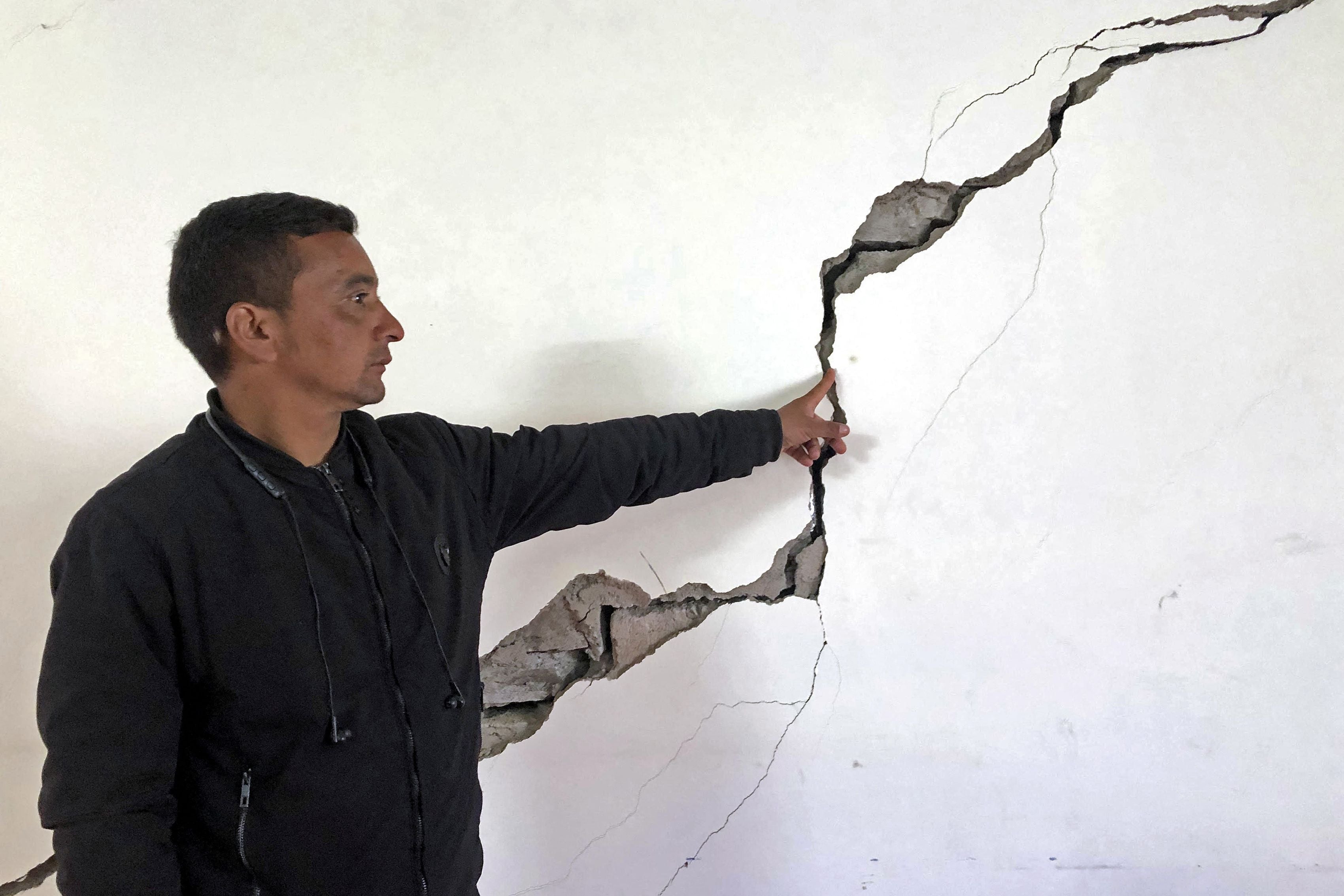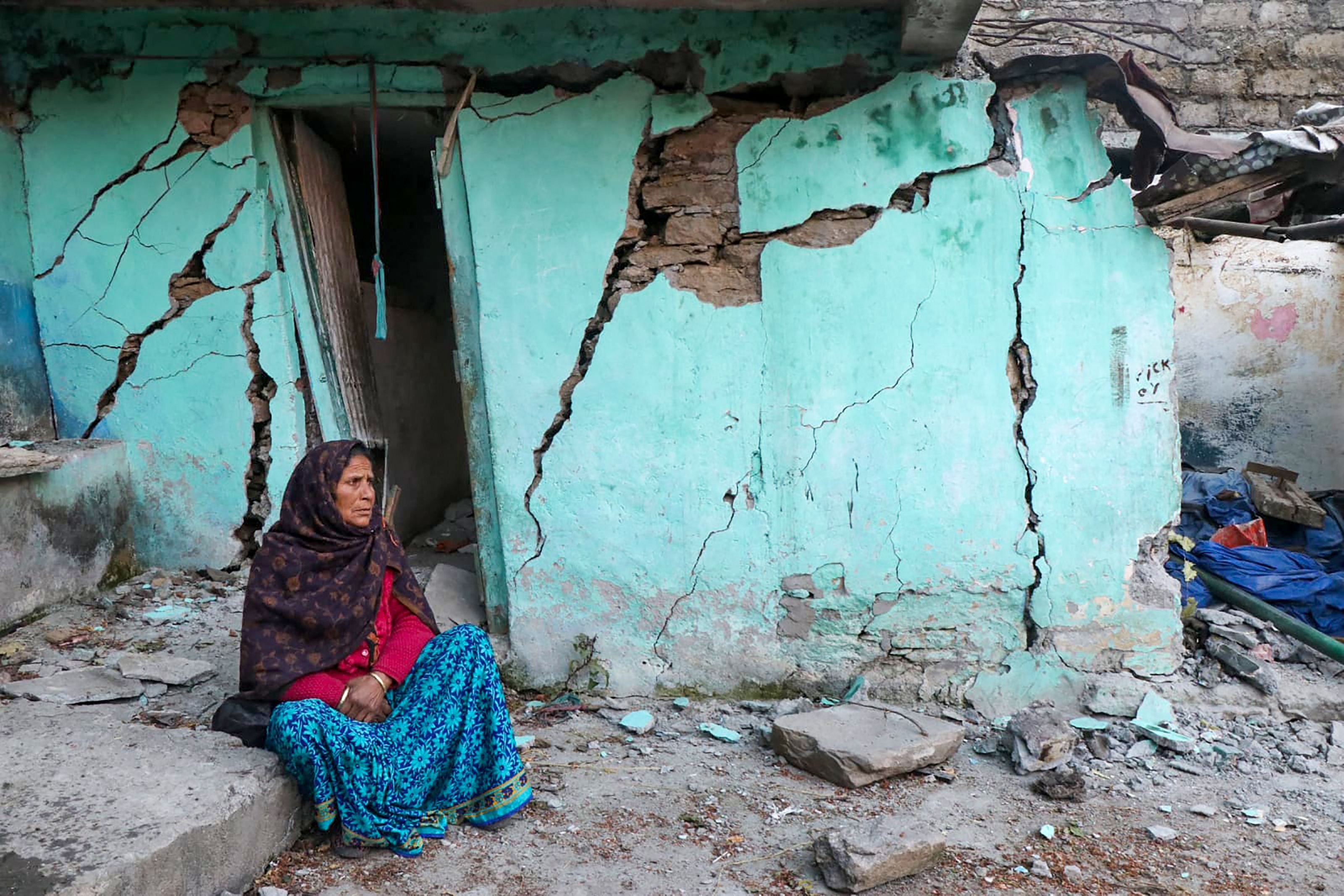‘Our worst nightmare has come true’: The crisis facing the sinking Himalayan town of Joshimath
Hundreds of people have been evacuated with large cracks appearing in buildings – with activists alleging development projects have made the situation worse, writes Stuti Mishra


In the last two weeks, residents in a remote Himalayan town in India – near the border with China – have witnessed large cracks appearing in their walls.
More than 600 houses in Joshimath, a town of around 20,000 people had been impacted, along with other buildings, roads and fields. Hundreds of people are now living in evacuation camps.
Authorities have declared the area, situated at an altitude of 6,151ft on a hillside where two valleys meet, a “sinking town” – prone to landslides and subsidence. Officials are now set to demolish some of the damaged buildings.
While land subsidence, a gradual sinking of the ground due to the movement of materials underground, can be caused due to natural factors such as earthquakes, soil erosion, and soil compaction – it can also be triggered by man-made activities such as mining or drilling for oil and water.
The situation has caused panic in the ecologically fragile Himalayan region. The cracks on the walls aren’t new for people in the town, who have protested for a long to protect their residential areas. However, the situation has worsened markedly recently.
“Land subsidence has been going on slowly in Joshimath for quite some time but it has increased over the past week with huge cracks appearing in houses, fields and roads,” Sushil Kumar, the commissioner of Garhwal, told local media outlets.
“The situation worsened apparently after a water channel beneath the town erupted last week,” he said.
There are several factors at play behind the sudden occurrence of large cracks, including the changing climate and geography of the area. However, experts have also been raising alarms over the “irreparable damage” caused by “rampant infrastructure development” for years.
The Indian state of Himachal Pradesh faces frequent natural calamities such as landslides, earthquakes and flash floods. But activists and experts suggest construction activities in the area are triggering more disasters.

“We have been repeatedly warning authorities about the irreparable damage caused due to several tunnel and hydropower projects in and around Joshimath and other parts of Uttarakhand,” says Atul Satti, a local environmental activist.
“However, our voices were blatantly ignored and our worst nightmare has come true today.”
The disaster is also bringing renewed attention to the ongoing hydropower projects, as activists blame drilling activities, especially related to the nearby project by the National Thermal Power Corporation Limited (NTPC).
“The entire responsibility of Joshimath caving in is on NTPC’s Tapovan Vishnugad Hydro Power Project. Continuous blasting in the tunnels have shaken the foundation of our town,” Mr Satti says.
After more cracks started to appear recently, authorities stopped all construction activities in the area. However, activists say these projects, including the construction of the new road to facilitate religious tourism in the area, must be stalled.
NTPC has denied any responsibility, saying that ts tunnelling and other work cannot be blamed for the cracks in the town, adding that “no blasting is being carried out in presently” in the region.
“The tunnel built by NTPC does not pass under Joshimath town. This tunnel is dug by a tunnel boring machine (TBM) and no blasting is being carried out presently,” NTPC said in a statement.
“There is no way the project is behind the subsidence,” a government official, told Reuters on condition of anonymity, adding that NTPC suspended tunnelling work in the area more than two years ago after a boring machine got stuck.
A report by The Indian Express claimed that since December 2009, there have been a string of “aquifer ingress” events — incidents where a TBM breaks into the rock that holds groundwater — along the tunnel of the Tapovan Vishnugad hydro project. The Independent has reached out to NTPC for further clarification.
Joshimath is situated on the debris of a landslide. While construction activities in the region have led to concerns from local activists for years, several studies have also pointed out how large hydropower projects are impacting existing land use and disturbing the ecological balance of the area.
Experts say that the apathy of local authorities and the climate crisis have also exacerbated the issues the area faces in recent years.
“There are two aspects to Joshimath problem,” explains Dr Anjal Prakash, who has previously been the lead author of UN Intergovernmental Panel on Climate Change (IPCC) reports. “First is rampant infrastructure development which is happening in a very fragile ecosystem like the Himalayas and this is happening without much of a planning process.

“Secondly, climate change is a force multiplier,” he says. “The way climate change is manifesting in some of the hilly states of India is unprecedented.”
The warming temperature, melting glaciers and changing pattern of monsoon has led to an increased number of disasters in the region with frequent landslides and flooding claiming lives.
The Himachal Pradesh State Disaster Management Plan on climate change has identified that the average mean surface temperature of the state has risen by about 1.6C in the last century.
There is consensus among meteorologists and geological experts that the Himalayan state faces a significant impact from global warming and the climate crisis.
“There has been a significant rise in extreme weather events across the state, with a steep rise in frequency as well as the intensity of relentless rainfall, cloud burst, flash flooding, landslides, and mudslides. Deforestation has also been the major cause of these disasters,” says Mahesh Palawat, a meteorologist at Skymet Weather.
According to officials, more than 1550 people lost their lives in the last five years in the region due to flooding-related disasters. In 2021 alone, 476 people died in the broader area of Himachal Pradesh during monsoon season.
Professor Y P Sundriyal, head of the geology department at HNB Garhwal University says the government needs to take a lesson from past disasters.
“The Himalayas is a very fragile ecosystem. Most parts of Uttarakhand are either located in seismic zone V or IV which are prone to earthquakes. Climate change is further worsening the matter, with more extreme weather events,” he says.
“We need to have the formation of some strong rules and regulations and forced and timely implementation of these rules. We are not against development but not at the cost of disasters.”
Dr Prakash also stresses that the rising challenges due to the warming planet require “a very strong planning process” which prioritises protecting the region first.
The situation in Joshimath is a warning sign for other local areas. Nearby towns such as Karnaprayag and Gopeshwar in the Chamoli district, where Joshimath is situated, have also reported continuous land subsidence.
Experts say in order to avoid damage such as that seen in Joshimath, the planning in the area should be done at a broader regional level and what is seen as a prioritisation of development projects over ecological damage needs to stop.
Dr Prakash suggests it might be time for the Indian government to look for other ways of energy generation. “The return investment cost in hydropower projects is very less when compared to the cost associated with environmental and ecological damage,” he says.
“Joshimath is a clear example of what one should not do in the Himalayas,” he adds.
Join our commenting forum
Join thought-provoking conversations, follow other Independent readers and see their replies
Comments


Bookmark popover
Removed from bookmarks